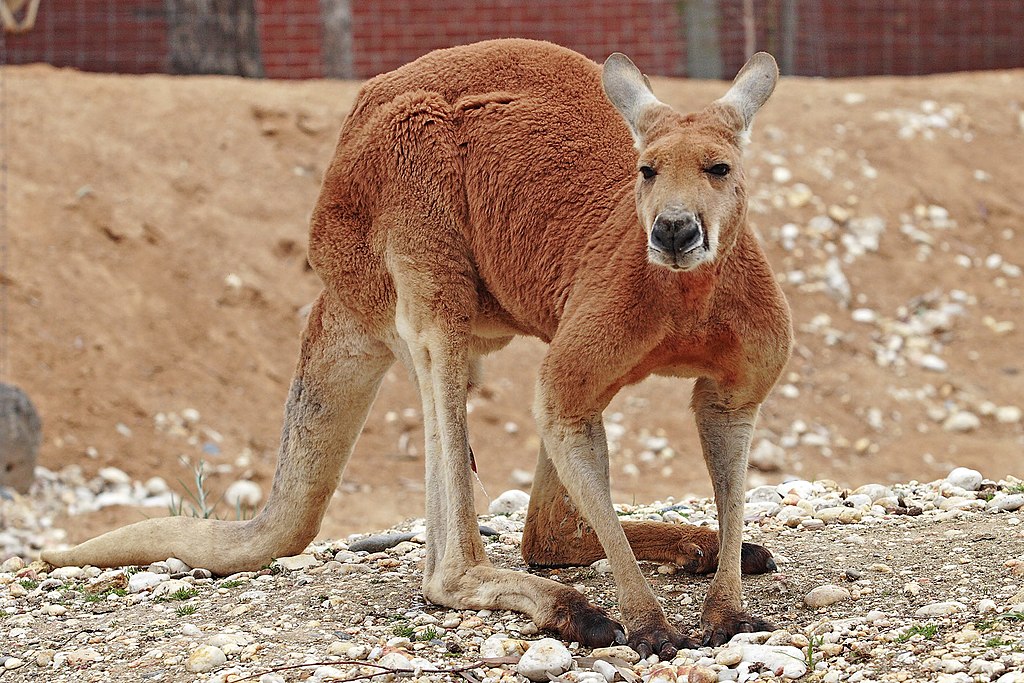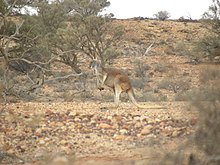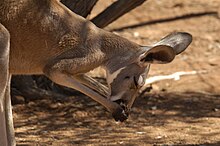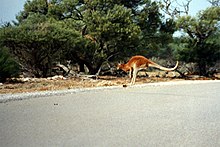
Male at Melbourne Zoo
Female at Nashville Zoo
Description
Female red kangaroo at Botanic Garden Zoo in Wagga Wagga, Australia
Males grow up to a head-and-body length of 1.3–1.6 m (4.3–5.2 ft) with a tail that adds a further 1–1.2 m (3.3–3.9 ft) to the total length. Females are considerably smaller, with a head-and-body length of 85–105 cm (33–41 in) and tail length of 65–85 cm (26–33 in).[4][5] Females can weigh from 18 to 40 kg (40 to 88 lb), while males typically weigh around twice as much at 55 to 90 kg (121 to 198 lb).[5][6] The average red kangaroo stands approximately 1.5 m (4.9 ft) tall to the top of the head in upright posture.[7] Large mature males can stand more than 1.8 m (5.9 ft) tall, with the largest confirmed one having been around 2.1 m (6.9 ft) tall and weighed 91 kg (201 lb).[6]
The red kangaroo maintains its internal temperature at a point of homeostasis about 36 °C (97 °F) using a variety of physical, physiological, and behavioral adaptations. These include having an insulating layer of fur, being less active and staying in the shade when temperatures are high, panting, sweating, and licking its forelimbs.
The red kangaroo's range of vision is approximately 300° (324° with about 25° overlap), due to the position of its eyes.[8]
Ecology and habitat
Red kangaroo in an arid environment
Red kangaroo at Desert Park, Alice Springs
At times, red kangaroos congregate in large numbers; in areas with much forage, these groups can number as much as 1,500 individuals. Red kangaroos are mostly crepuscular and nocturnal, resting in the shade during the day.[15] However, they sometimes move about during the day. Red kangaroos rely on small saltbushes or mulga bushes for shelter in extreme heat rather than rocky outcrops or caves.[11] Grazing takes up most of their daily activities. Like most kangaroo species, they are mostly sedentary, staying within a relatively well-defined home range. However, great environmental changes can cause them to travel great distances.[11] Kangaroos in New South Wales have weekly home ranges of 258–560 ha, with the larger areas belonging to adult males.[16] When forage is poor and rainfall patchy, kangaroos will travel 25–30 km to more favourable feeding grounds.[13] Another study of kangaroos in central Australia found that most of them stay close to remaining vegetation but disperse to find fresh plants after it rains.[17] The red kangaroo is too big to be subject to significant non-human predation. They can use their robust legs and clawed feet to defend themselves from attackers with kicks and blows. However, dingoes and eagles will kill and eat joeys. Joeys are thus protected in their mother's pouch. The red kangaroo formerly did have major predators that are now extinct. Extinct predators included the marsupial lion, Megalania, and the wonambi. Kangaroos are adept swimmers, and often flee into waterways if threatened by a predator. If pursued into the water, a kangaroo may use its forepaws to hold the predator underwater so as to drown it.[18]
Behaviour
Mob of red kangaroos at the Wagga Wagga Botanic Gardens
Fighting red kangaroos
Reproduction
See also: Kangaroo § Reproduction and life cycle
The red kangaroo breeds all year round. The females have the unusual
ability to delay birth of their baby until their previous Joey has left
the pouch. This is called embryonic diapause. Copulation may last 25 minutes.[21]
The red kangaroo has the typical reproductive system of a kangaroo. The
neonate emerges after only 33 days. Usually only one young is born at a
time. It is blind, hairless, and only a few centimetres long. Its hind
legs are mere stumps; it instead uses its more developed forelegs to
climb its way through the thick fur on its mother's abdomen
into the pouch, which takes about three to five minutes. Once in the
pouch, it fastens onto one of the two teats and starts to feed. Almost
immediately, the mother's sexual cycle
starts again. Another egg descends into the uterus and she becomes
sexually receptive. Then, if she mates and a second egg is fertilised,
its development is temporarily halted. Meanwhile, the neonate in the
pouch grows rapidly. After approximately 190 days, the baby (called a joey)
is sufficiently large and developed to make its full emergence out of
the pouch, after sticking its head out for a few weeks until it
eventually feels safe enough to fully emerge. From then on, it spends
increasing time in the outside world and eventually, after around
235 days, it leaves the pouch for the last time.[22]
While the young joey will permanently leave the pouch at around
235 days old, it will continue to suckle until it reaches about
12 months of age. A doe may first reproduce as early as 18 months of age
and as late as five years during drought, but normally she is two and a
half years old before she begins to breed.[23]The female kangaroo is usually permanently pregnant, except on the day she gives birth; however, she has the ability to freeze the development of an embryo until the previous joey is able to leave the pouch. This is known as diapause, and will occur in times of drought and in areas with poor food sources. The composition of the milk produced by the mother varies according to the needs of the joey. In addition, red kangaroo mothers may "have up to three generations of offspring simultaneously; a young-at-foot suckling from an elongated teat, a young in the pouch attached to a second teat and a blastula in arrested development in the uterus".[21]
The kangaroo has also been observed to engage in alloparental care, a behavior in which a female may adopt another female's joey. This is a common parenting behavior seen in many other animal species like wolves, elephants and fathead minnows.[24]
Relationship with humans
A red kangaroo crossing a highway
Kangaroos dazzled by headlights or startled by engine noise often leap in front of vehicles, severely damaging or destroying smaller or unprotected vehicles. The risk of harm to vehicle occupants is greatly increased if the windscreen is the point of impact. As a result, "kangaroo crossing" signs are commonplace in Australia.
Commercial use

The kangaroo is so numerous that there is regulated harvest of its hide and meat. Hunting permits and commercial harvesting are controlled under nationally approved management plans, which aim to maintain red kangaroo populations and manage them as a renewable resource. Harvesting of kangaroos is controversial, particularly due to the animal's popularity.[23]
In the year 2000, 1,173,242 animals were killed.[25] In 2009 the government put a limit of 1,611,216 for the number of red kangaroos available for commercial use. The kangaroo industry is worth about A$270 million each year, and employs over 4000 people.[26] The kangaroos provide meat for both humans and pet food. Kangaroo meat is very lean with only about 2% fat. Their skins are used for leather.







No comments:
Post a Comment
Note: Only a member of this blog may post a comment.